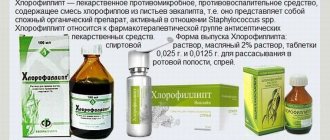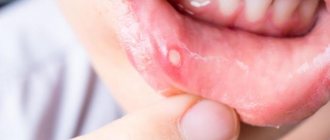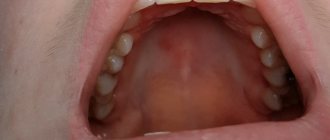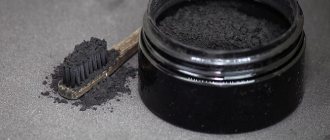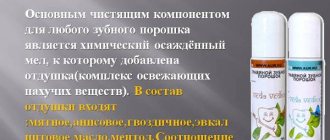Hexoral for stomatitis is one of the most effective drugs. It has a wide spectrum of action, therefore it is approved for both fungal and herpetic stomatitis. Self-medication for stomatitis is not recommended, since this disease develops rapidly and is fraught with dangerous complications. Hexoral cannot be used uncontrollably; the active components can cause side effects.
About the drug
Hexoral is a drug that has antimicrobial, analgesic, antiseptic and hemostatic effects. The active substance is hexetidine. It actively fights gram-positive and gram-negative microorganisms and promotes pain relief. The drug envelops the mucous membrane, providing a long-lasting effect.
Hexoral also contains essential oils, methyl salicylate and other components designed to enhance the antimicrobial effect of the product. Hexoral forms a thin film on the mucous membrane, which prevents the proliferation of harmful microorganisms. The advantage of Hexoral is its versatile effect on the mucous membrane: destruction of bacteria and fungi, stopping bleeding, enveloping and anesthetizing, accelerating the healing process of ulcers.
The therapeutic effect is achieved not only by improving blood supply and stimulating tissue regeneration, but also due to the reflex reaction that occurs when receptors are irritated. Hexoral is prescribed for inflammatory processes in the oral cavity. It is noteworthy that the drug is approved for both adults and children.
Causes of stomatitis in adults
Pathogenic bacteria, viruses. Inflammation begins due to the action of pathogens of viral or infectious diseases. Normally, they are located in the oral cavity and do not cause irritation. The mucous membrane is protected from inflammation by the immune system. If it is weakened, viruses or bacteria can cause stomatitis.
Deficiency of vitamins and microelements. If the body receives little zinc, iron, folic acid, or B vitamins, the risk of stomatitis increases. Such a deficiency occurs due to irregular or unbalanced nutrition and consumption of foods with low nutritional value.
Injuries to the mucosal surface. The mucous membrane can be injured mechanically, by temperature or chemical irritants. Mechanical injuries occur when biting the cheek, damaging its inner surface with the edge of a crown, prosthesis, or hard food. When injured by a chemical irritant, contact occurs with acids, alkalis, and salt. Thermal injuries occur when consuming hot food or drinks. Minor and irregular injuries heal without stomatitis. It develops if injury to a certain area occurs regularly or when the immune system is weakened. In particular, when smoking, the surface of the mucous membrane is constantly injured both thermally and mechanically.
Insufficient hygiene. This reason is more typical for children. The risk also exists for adults. It is associated with insufficient personal hygiene. Inflammatory agents enter the oral cavity if you do not wash your hands before eating or eat unwashed foods.
Improper oral hygiene. Too frequent brushing or rinsing, constant brushing of teeth with a paste that contains sodium lauryl sulfate, reduce salivation, which causes the mucous membrane to become dehydrated and vulnerable to irritants.
Drug treatment. Taking diuretics and some other drugs can reduce salivation and provoke dehydration of the mucous membrane. If the mucous membrane is dry, the risk of mechanical injuries and accumulation of pathogenic microorganisms increases.
Accompanying illnesses. If the body is weakened, the risk of developing an inflammatory process increases. Stomatitis can be provoked by cancer, systemic diseases, HIV, gastrointestinal diseases, hormonal imbalances, diabetes mellitus, candidiasis, helminthic infestation, and bronchial asthma. Often, inflammation of the mucous membrane is provoked not by the disease itself, but by the use of medications that are used in its treatment.
Do you have questions about stomatitis in adults?
We will call you back within 30 seconds
+7
How to use Hexoral for stomatitis
Hexoral is most effective for herpetic and fungal stomatitis. In addition to stomatitis, Hexoral helps with laryngitis, pharyngitis, tonsillopharyngitis, purulent sore throat, colds and fungal infections. It must be remembered that any drug is fully effective only when it is used in accordance with the instructions.
If a solution was prescribed for the treatment of ulcers, treatment should be carried out twice a day after meals. You need to moisten a cotton swab with the solution and apply it to the affected area for 30 seconds. When using an aerosol, spray within two seconds. It is important not to swallow saliva for a while after the procedure.
The duration of the therapeutic course is determined only by the doctor, taking into account the severity of the disease. Hexoral is not used as monotherapy. Stomatitis can only be cured in a comprehensive way: diet, bed rest, drugs that strengthen the immune system.
Mode of application
Hexoral® is sprayed into the mouth or throat. Using the spray, you can easily and quickly treat the affected areas. You need to do the following:
- The nozzle should be installed in the corresponding hole on the head of the bottle, pressing lightly on it. Point the end of the flexible tube away from you;
- Hold the nozzle in your mouth and direct it to the appropriate area of the mouth or throat. During the procedure, always keep the bottle upright;
- While holding your breath, inject Hexoral® spray by pressing the head of the balloon for 1-2 seconds.
- Use no more than 3 times a day (depending on the severity of the disease or doctor’s recommendations).
- The duration of treatment is determined by the doctor individually.
Release forms
Solution
The solution is sold in 200 ml bottles. Liquid Hexoral has a red tint and a pleasant mint aroma. The main part of the solution is ethyl alcohol, the rest: mint oil, essential oils (anise, cloves, eucalyptus), citric acid, levomenthol.
Hexoral solution is prescribed for rinsing with sore throat, stomatitis, pharyngitis and other inflammations of the oral cavity of a bacterial or fungal nature. The drug also helps to treat the throat and oral cavity after surgery.
Hexoral solution is intended for rinsing, irrigating and wetting the oral cavity. The drug has a local effect: eliminates cough, pain and discomfort, heals ulcers and wounds, relieves swelling of the mucous membrane. Only if you use it after meals can you achieve the maximum effect, since this way the product remains on the mucous membrane and acts until the next meal.
For rinsing with stomatitis, use an undiluted solution of Hexoral. It should be applied to the mucous membrane carefully using a cotton pad. The drug should not be swallowed. When treating stomatitis, two or three treatments per day after meals are sufficient. Before use, you need to clean your mouth.
If side effects occur during treatment, you should stop using the drug and consult your doctor. Under such circumstances, it is recommended to replace the medicine with analogues.
Aerosol
Aerosol (40 ml) Hexoral is colorless. The drug helps cope with pain and other symptoms of inflammation. The aerosol contains hexetidine, menthol, citric acid, essential oils (mint, eucalyptus).
Most often, the aerosol is prescribed for stomatitis in children. However, you need to remember that the spray is dangerous for very young children (under 3 years old), since its use can provoke laryngospasm. The medicine is applied to the affected mucous membrane with one or two injections.
Hexoral should not be swallowed, and therefore you should hold your breath when using the aerosol. If the product gets into the lungs, it can provoke bronchospasm.
It is noteworthy that Hexoral for spraying is an aerosol, not a spray. The difference between them is the size of the suspended particles, and then the aerosol has a more aggressive spray pattern. Therefore, if you do not hold your breath while spraying, you can provoke an attack of suffocation in patients prone to allergies.
Pills
The high effectiveness of Hexoral tablets is due to the activity of chlorhexidine and benzocaine. These substances destroy pathogenic microorganisms and reduce pain. Long-term therapy, including Hexoral tablets, can cause changes in taste perception and numbness of the mouth.
Tablets and lozenges are contraindicated in children under 6 years of age. Children over 12 years of age and adults can dissolve the drug 6-8 times a day (no more than a lozenge in two hours). If a doctor prescribes tablets for a child (over 4 years old), you should not take more than four tablets per day. If breastfeeding, you should first consult your doctor.
Note!
Description of the drug Hexoral spray for mouth. floor. 0.2% fl. 40ml on this page is a simplified author’s version of the apteka911 website, created on the basis of the instructions for use.
Before purchasing or using the drug, you should consult your doctor and read the manufacturer's original instructions (attached to each package of the drug). Information about the drug is provided for informational purposes only and should not be used as a guide to self-medication. Only a doctor can decide to prescribe the drug, as well as determine the dose and methods of its use.
Can Hexoral be used for children?
Children under 3 years of age are not prescribed Hexoral solution for rinsing. The aerosol can only be used from 4 years of age. This is due to the high allergenicity of the drug and the presence of a large list of contraindications. If it enters the stomach and bronchi, ethyl alcohol, which is part of Hexoral, can cause poisoning. It is noteworthy that the aerosol contains three times more ethyl alcohol than the solution.
Lollipops are contraindicated for children under 4 years of age due to the presence of benzocaine, which can cause disruption in the functioning of important systems of the growing body. In addition, benzocaine can change the composition of the blood (methemoglobinemia), which can lead to suffocation and blue discoloration of the skin. Hexoral tablets are approved for children over 12 years of age.
There is no special Hexoral spray for children for the reason that children do not know how to properly carry out the irrigation procedure and hold their breath. Thus, the child swallows the drug, which is fraught with unpleasant symptoms.
Hexoral during pregnancy
Doctors do not consider pregnancy a direct contraindication to the treatment of stomatitis with Hexoral. However, there are no reliable studies that would refute the danger of the drug for pregnant women and nursing mothers (WHO prohibits any studies involving such patients).
Since Hexoral has a local effect, it minimizes the effect on the fetus. In any case, treatment of stomatitis with this drug can only be carried out with the permission of the attending physician. Often, strong drugs, like Hexoral, are prescribed only when stomatitis poses a great threat to the child and mother.
Contraindications and side effects
Hexoral is extremely rarely prescribed to children under 3 years of age. The drug is contraindicated for people with hypersensitivity to the components. If you are prone to allergies, you should use Hexoral therapy with caution.
Possible side effects:
- nausea and vomiting;
- convulsions;
- breathing problems;
- dysfunction of the cardiovascular system;
- change in taste perception;
- numbness of the oral cavity;
- change in tooth color.
Overdoses of Hexoral occur extremely rarely. If a child swallows the drug and experiences nausea and vomiting, contact a medical facility immediately. Before arriving at the hospital, you can give your child activated charcoal.
Types of stomatitis
Due to the variety of types of inflammation of the mucous membrane, it is impossible to describe them all within the framework of the article. The most common forms of the disease are:
- catarrhal;
- ulcerative;
- aphthous: acute and chronic.1,4,8
Catarrhal stomatitis
Catarrhal stomatitis develops most often with violation of the rules of oral hygiene, a large amount of soft and hard dental plaque, and the use of dental prostheses1,4,6.
What does catarrhal stomatitis look like?
The mucous membrane of the oral cavity, gums and gingival papillae, the mucous membrane of the inner surface of the cheeks, as well as the tongue and palate are red, swollen, covered with a white coating, which can then turn brown. Eating causes pain, the mucous membrane begins to bleed at the slightest irritation1.
With simple catarrhal inflammation, only the superficial layer of the oral mucosa is affected, so this stomatitis is quite easy to treat. If stomatitis does not go away, this is a reason to examine the gastrointestinal tract1,4.
Ulcerative stomatitis
Ulcerative stomatitis can develop as a complication of catarrhal disease or as a separate pathology. Most often it occurs against the background of gastric and duodenal ulcers, chronic enteritis, sometimes with diseases of the cardiovascular system, and general infections1,4,5,6.
In the ulcerative form of stomatitis, the entire thickness of the mucous membrane is affected4. Initially, areas of redness and swelling appear on it (usually under the tongue and on the buccal surface). There is a burning sensation in the mouth, which intensifies when eating4,5. On the 2-3rd day of the disease, a dirty gray plaque forms at the site of the lesion, and after its rejection, painful ulcers appear1,5.
Ulcers can be single or multiple, sometimes they merge with each other and form extensive ulcerated areas. The volume of the lesion determines the severity of the disease. Thus, with severe inflammation, symptoms of general intoxication are observed: weakness, increased fatigue, headache, fever up to 37.50 C1,4,5,6.
In addition to the listed symptoms, with ulcerative stomatitis, the lymph nodes under the lower jaw and on the anterolateral surface of the neck enlarge4,5,6. Saliva becomes viscous, viscous, the smell from the mouth becomes fetid, putrefactive1.5.
How many days does ulcerative stomatitis last? Proper treatment started in a timely manner promotes healing of ulcers within 8-10 days. If you do nothing and wait until the stomatitis goes away on its own, the inflammation can spread deeper and involve the jaw bones - osteomyelitis will develop1,5.
Aphthous stomatitis
Aphthous stomatitis is characterized by the formation of single or multiple aphthous stomatitis on the oral mucosa1,2,3,4,6.
Aphthae are round-shaped formations, the size of a lentil grain, with a grayish-yellowish coating in the center and a narrow rim of redness along the periphery4,6,9. After the plaque is rejected, a small and extremely painful ulcer forms in the center of the aphthae, which, when healing, turns into a red spot. This spot lasts only a few days and then disappears without a trace1,3,9.
Aphthous inflammation can occur in acute and chronic forms1,2. In acute cases, the appearance of aphthae during stomatitis is accompanied by pain in the mouth, weakness, weakness, and increased body temperature4. As the rash disappears during treatment of stomatitis, the condition quickly improves - recovery is observed1,3.
With chronic aphthous inflammation, there are no general symptoms, and the number of emerging aphthae is limited to 1-3. The disease exists for many years, worsening mainly in spring and autumn1,2,3.
How long does aphthous stomatitis last? With proper treatment, its manifestations disappear within 7-10 days1,2,3. Acute forms of pathology may never recur, and chronic inflammation may not bother you for a long time or, conversely, worsen with the slightest decrease in immunity1,2,3,9.
Up to contents
Overdose
When the solution is swallowed, vomiting often occurs, which helps to get rid of toxic substances. That is why an overdose of Hexoral rarely occurs. If a large amount of the product gets into the stomach, you need to rinse it. If a child has swallowed a lot of Hexoral, rinsing is vital, since due to the high concentration of ethyl alcohol, the baby may experience severe alcohol poisoning.
Caution should also be exercised when using tablets and lozenges. Despite the pleasant taste and relative safety, Hexoral in tablet form is a medicine. Even lollipops cannot be used if you have a severe allergy to the components.
In case of overdose, benzocaine, which is part of Hexoral lozenges, can cause tremors, convulsions, vomiting and breathing problems. Sometimes patients' heart rate slows down, and in severe cases, atrioventricular block and even cardiac arrest occur.
Geksoral's analogs
Before you buy an analogue of Hexoral, you need to read the instructions. In most cases, those drugs that are advertised as milder and safer are not much different from Hexoral. For example, Tantum Verde is often recommended as a gentle analogue, although these remedies are very similar in effectiveness and side effects. However, Tantum Verde is not an absolute analogue, since its effectiveness is due to the action of benzydiamine. In case of overdose, this substance provokes ketonuria and laryngospasm.
Despite the fact that Tantum Verde is positioned as safe for children, it should not be used by patients under 3 years of age. The advantage of this drug is low allergenicity due to the absence of essential oils in the composition. Tantum Verde is produced in the form of a spray, so it is more gentle, and side effects are observed very rarely.
It is often recommended to replace Hexoral tablets with Grammidin. This is a domestic drug that is effective in treating throat diseases. However, it contains an antibiotic, so it cannot be considered a direct analogue of Hexoral.
You can often come across the opinion that IRS-19 spray is an absolute analogue of Hexoral. But the first remedy is indicated for sore throat and diseases of the oral cavity, and the second is effective in the midst of an epidemic of viral infection.
Geksoral's analogues:
- Stomatidin. A combined agent that has antiseptic, analgesic and anti-inflammatory effects. The active ingredient is hexetidine. Indicated for infectious and fungal infections, as well as injuries to the oral cavity and pharynx. Not prescribed for atrophic pharyngitis, children under 4 years of age and pregnant women (1st trimester).
- Maxisspray. An antiseptic drug prescribed for acute pharyngitis, tonsillitis, stomatitis and gingivitis. Contraindicated for children under 8 years of age and for pregnant women (1st trimester).
- Stopangin. Complex anti-inflammatory and antimicrobial drug based on hexetidine.
For any disease of the oral cavity, you cannot get by solely with Hexoral or some other drug. Treatment of such pathologies must be comprehensive. Only an otolaryngologist who is able to assess all the risks and benefits of such therapy can prescribe the drug. Often, for stomatitis in children, doctors prescribe milder drugs that do not cause side effects, unlike the potent Hexoral.
The shelf life of the medicine is 2 years (for tablets 3 years). The average cost of Hexoral solution is 150 rubles, tablets – 100 rubles, aerosol – 17 rubles.
Sources used:
- Rational pharmacotherapy in dentistry. — M.: Litterra
- Medicines in dentistry. Directory / L.N. Maksimovskaya, P.I. Roshchina. — M.: Medicine
- The use of non-steroidal anti-inflammatory drugs for the treatment of dental diseases / S.T. Sokhov et al. - M.: MEDpress-inform, 2011.
- Material from Wikipedia
Literature
- Bazhanov N. N. Dentistry: Textbook, 6th ed., revised. and additional - M.: GEOTAR-MED, 2002. - P. 96-102 - ISBN 5-9231-0272-2.
- Bulkina N.V., Lomakina D.O., Meleshina O.V. Chronic recurrent aphthous stomatitis: features of the clinical course and complex treatment // Saratov Journal of Medical Scientific Research. - 2011. - T. 7. - No. 1 (appendix). — P. 281-282.
- Galizina O.A. Main aspects of the occurrence, clinical manifestations, treatment and prevention of chronic recurrent aphthous stomatitis. CLINICAL STUDIES // RUSSIAN DENTAL JOURNAL, No. 6, 2014. - pp. 39-42
- O.A. Zorina, N.B. Petrukhina, L.M. Kozlova. Treatment of aphthous stomatitis in adolescents // Pediatric pharmacology. 2014; 11(3). — P. 85–88.
- Lutskaya I.K. Ulcerative-necrotic stomatitis in adults and children: diagnosis, treatment and prevention // Modern dentistry. – 2018. – No. 2. – pp. 17–20.
- Belousova O.V., Belousov E.A., Dorokhova N.N. Application of pharmacoeconomic methods to optimize the procurement of drugs for the treatment of stomatitis in a pharmacy // Scientific result. Medicine and pharmacy. – T.3, No. 1, 2021. – P. 48-55.
- Mavrutenkov V.V. Viral stomatitis // Child's Health, No. 3 (63), 2015. - P. 63-68.
- K. G. Karakov Fungal, viral and traumatic stomatitis in the clinic of therapeutic dentistry // Textbook / 2013. – 100 s. /ISBN 978-5-89822-345-8
- Volkov E.A., Butova V.G., Pozdnyakova T.I., Dzugaeva I.I. Clinical recommendations (treatment protocol) for chronic recurrent aphthous stomatitis. // Russian Dental Journal, No. 5, 2014 p. 35-48/UDC 616.31-002.157.2-036.12-08
- Instructions for use of the drug HEXORAL® aerosol // Reg. number P N014010/01 // .
- Instructions for use of the drug HEXORAL® solution: , .
- Instructions for use of the drug HEXORAL® TABS // Reg. number LSR-002626/07 // .
- Instructions for use of the drug HEXORAL® TABS CLASSIC // Reg. number P N015976/01 // .
- Instructions for use of the drug HEXORAL® TABS EXTRA // Reg. number LSR-004122/09 // .

